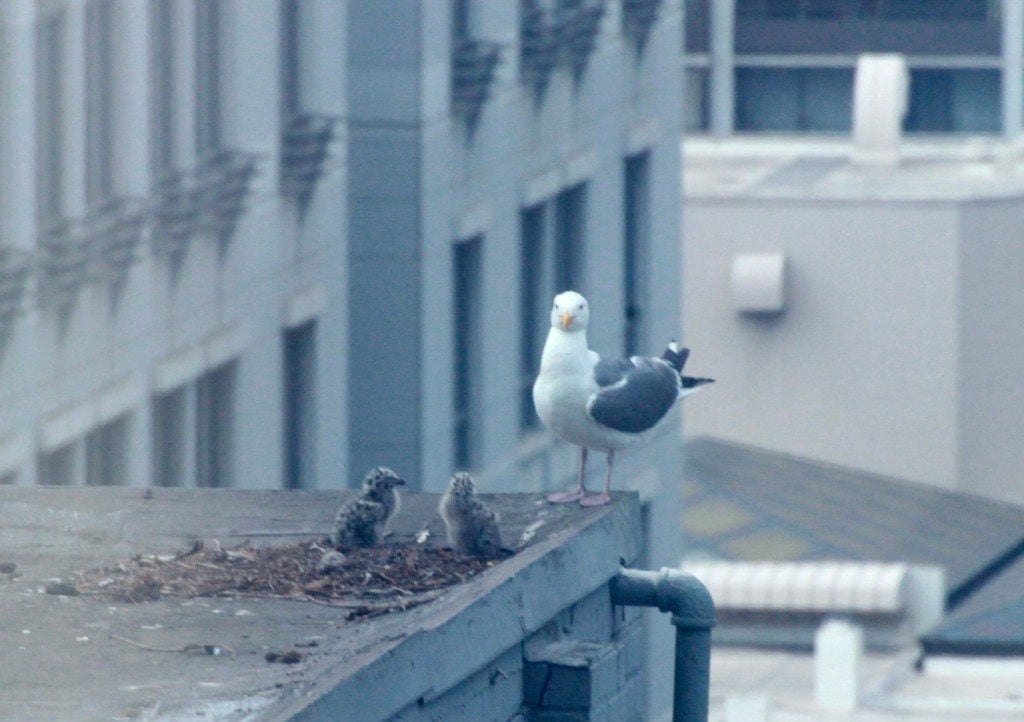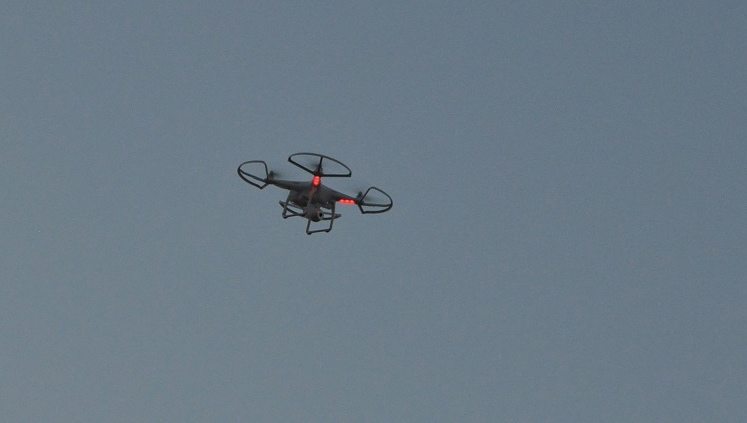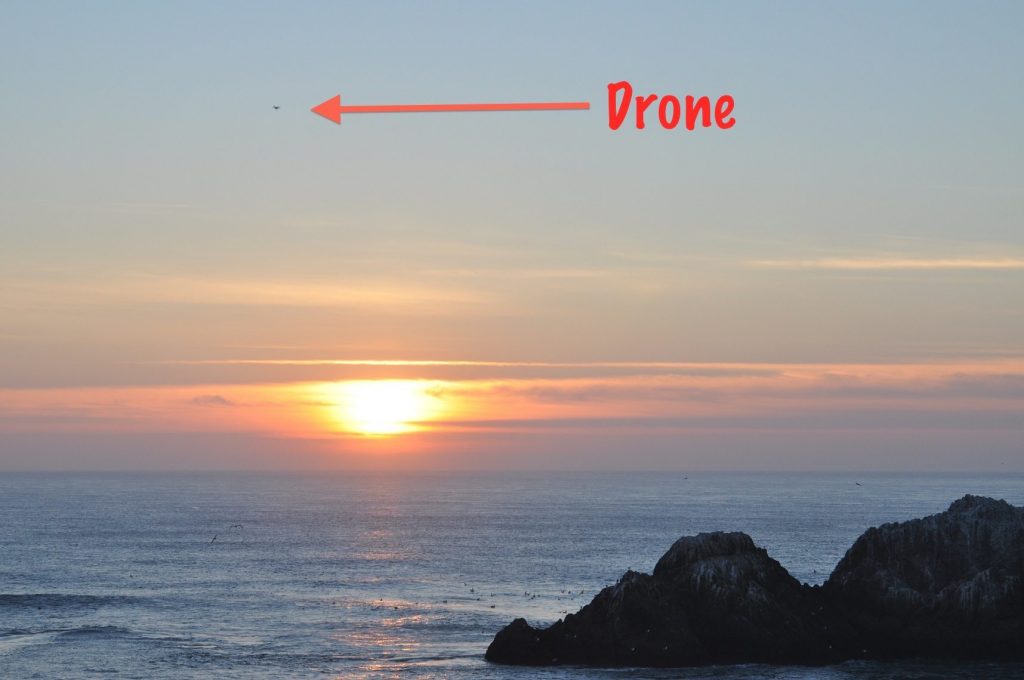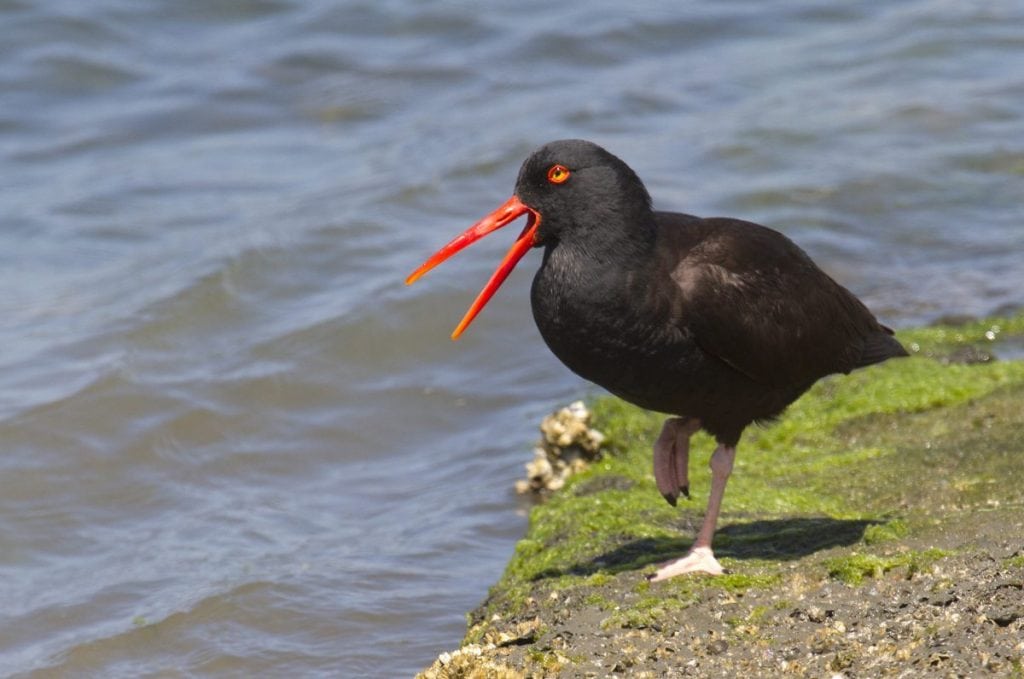Drones and birds — a growing conflict?
By Ilana DeBare
The rocky oceanfront near San Francisco’s Sutro Baths is a key nesting spot for shorebirds such as Black Oystercatchers and Brandt’s Cormorants. So longtime birder Alan Hopkins was dismayed last January when he started seeing recreational drones buzzing along that section of shore.
Sam Schuchat had been excited to see a pair of Western Gulls nesting on a ledge across from his office at the California Coastal Conservancy in downtown Oakland in June. Then a drone swooped by and frightened the parent gulls off their nest.
Drones and birds: At this point such unplanned encounters are still an anomaly. But as the commercial and recreational use of drones grows, so will the potential for them to disrupt and endanger wildlife.
Drones — pilotless aircraft that often resemble mini-helicopters — are spreading. The Federal Aviation Authority is finalizing rules this year that will allow the widespread use of commercial, non-military drones. As many as 10,000 to 30,000 commercial drones could be in the air by 2020, used for everything from scientific research and police surveillance to bridge repairs and package delivery. Many of the companies making drones are based in the Bay Area, tapping the engineering know-how and financing of Silicon Valley.
While it’s good that the FAA is developing rules to govern drone use, the proposed rules do not address the potential impacts on wildlife.
And the FAA’s oversight does not include recreational drones used by hobbyists – probably the kind sighted by Hopkins and Schuchat.
In most cases, a single scare from a passing drone isn’t likely to harm a bird. In the incident with the Oakland gull nest, the parent birds returned to the nest after the drone passed and successfully hatched some chicks.

But repetition raises the stakes.
Parent birds may abandon a nest if they’re disturbed repeatedly. Even one disturbance can leave their chicks temporarily vulnerable to predators. And flushing birds while they’re roosting or feeding makes it harder for them to build up the energy reserves for successful breeding and migration.
Many bird species today are already under severe pressure from loss of habitat and climate change. They will find it even harder to survive these challenges if their rest and feeding is constantly being interrupted by drones.



No major conservation group has so far launched a campaign about drones. But National Audubon released a short policy statement in June on “Managing Conflicts Between Birds and Unmanned Aerial Systems.”
National Audubon noted that drones can be a valuable conservation tool when used by scientists for tasks like nest monitoring or aerial photography of remote habitat.
A summer 2014 story in Audubon magazine pointed out that light-aircraft crashes are the most common death risk for wildlife biologists. Drones would allow scientists to study remote wildlife with less risk to human life.
Drones “could be an effective and efficient way to conduct research on birds if they are approached under carefully monitored conditions,” NAS wrote in its recent policy statement.
But NAS added that birds may be harassed, hurt, or killed in collisions with drones. (Click here to see video footage taken by a drone that was attacked by a hawk in Cambridge, Mass., in late 2014.)
“The exponential increase in Unmanned Aerial Systems [drones] has raised concerns about their effects on sensitive wildlife populations such as birds,” NAS warned.
NAS suggests some initial “best practices” for drone operators:
- Know laws protecting wildlife. Be aware of laws protecting migratory birds and endangered species from negative effects of human activities such as drones.
- Respect rules on public lands. Observe federal, state, local and tribal policies regarding drone use. (The drones at Sutro Baths were probably violating existing rules prohibiting drones in the Golden Gate National Recreation Area. But there are no signs saying that drones are prohibited there, and there has been no public education campaign targeted at drone operators.)
- Check posted signs and information web pages to be aware of sensitive areas with extensive bird numbers that should be considered no-fly zones.
- Recognize seasonal activities. Avoid activity over nesting or flightless birds or habitats used by birds for those activities during sensitive periods such as breeding or molting.
- Conduct a pre-flight check for birds in the flight area immediately before take-off. If birds are detected in that airspace, it should be avoided.
- Leave a 50-100 foot buffer from areas where birds are present flying, in trees, or on the ground. A recent quadcopter study indicated little response by waterbirds beyond 12 feet, but other types of UAS [drones], or different bird species, may elicit a response at greater distances.
What do you think?
Is there a way to get out front on this issue, and prevent drone-bird conflicts while drones are still relatively uncommon? How should we weigh the potential benefits of drones against their potential dangers? Do National Audubon’s suggestions go far enough? Should wildlife advocates work together with privacy advocates on the drone issue?
Let us know what you see, as well as what you think. Are you noticing drones when you’re out birding in the field? Are you noticing any effects on birds?
There’s very little data so far on drones and birds. We’re likely to learn more as drones become more common.
But wouldn’t it be nice to manage an environmental conflict before it happens for once, rather than waiting to learn from our mistakes?
